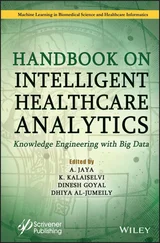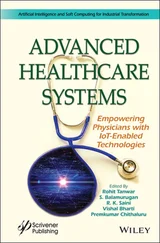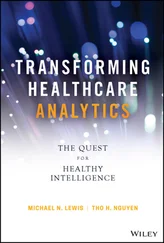Using Predictive Analytics to Improve Healthcare Outcomes
Здесь есть возможность читать онлайн «Using Predictive Analytics to Improve Healthcare Outcomes» — ознакомительный отрывок электронной книги совершенно бесплатно, а после прочтения отрывка купить полную версию. В некоторых случаях можно слушать аудио, скачать через торрент в формате fb2 и присутствует краткое содержание. Жанр: unrecognised, на английском языке. Описание произведения, (предисловие) а так же отзывы посетителей доступны на портале библиотеки ЛибКат.
- Название:Using Predictive Analytics to Improve Healthcare Outcomes
- Автор:
- Жанр:
- Год:неизвестен
- ISBN:нет данных
- Рейтинг книги:5 / 5. Голосов: 1
-
Избранное:Добавить в избранное
- Отзывы:
-
Ваша оценка:
- 100
- 1
- 2
- 3
- 4
- 5
Using Predictive Analytics to Improve Healthcare Outcomes: краткое содержание, описание и аннотация
Предлагаем к чтению аннотацию, описание, краткое содержание или предисловие (зависит от того, что написал сам автор книги «Using Predictive Analytics to Improve Healthcare Outcomes»). Если вы не нашли необходимую информацию о книге — напишите в комментариях, мы постараемся отыскать её.
Discover a comprehensive overview, from established leaders in the field, of how to use predictive analytics and other analytic methods for healthcare quality improvement. Using Predictive Analytics to Improve Healthcare Outcomes
before
proven in advance
Using Predictive Analytics to Improve Healthcare Outcomes
Using Predictive Analytics to Improve Healthcare Outcomes — читать онлайн ознакомительный отрывок
Ниже представлен текст книги, разбитый по страницам. Система сохранения места последней прочитанной страницы, позволяет с удобством читать онлайн бесплатно книгу «Using Predictive Analytics to Improve Healthcare Outcomes», без необходимости каждый раз заново искать на чём Вы остановились. Поставьте закладку, и сможете в любой момент перейти на страницу, на которой закончили чтение.
Интервал:
Закладка:
Our study used predictive analytics to answer the questions and question the assumptions of staff members and leaders. The data provided at every step in the process became the vehicle for us to go deeper into conversations about the everyday operations of the units. We now had predictive analytics to help us discover some things that would allow us to refine operations with an extremely high likelihood that our efforts would be successful. The aspects of care we investigated further, using the data, addressed:
The data provided at every step in the process became the vehicle for us to go deeper into conversations about the everyday operations of the units.
1 The quality of relationships on the unit,
2 How staff members assessed their own care delivery and that of others,
3 Whether there was consistency in our care delivery,
4 Whether the mission and values of the organization were visible and tangible in our care delivery, and
5 How well the hospital’s operational systems worked for delivering care to patients and families.
While these were nontraditional things to measure, we had confidence that by understanding them better, we could understand more clearly what predicted other outcomes. These variables were all front‐of‐mind because of our work with Relationship‐Based Care. And because these variables came directly from the people closest to the work, the results of this study described the actual behaviors of staff members and leaders, providing highly relevant, actionable information and insights regarding the care environment.
The data analyst guided the staff members and leaders to discover the information behind the data by learning to ask questions starting with “how” and “why.” The time we spent together further refining the questions, digging deeper, and examining hunches to answer these questions allowed for truly helpful stories to emerge from staff members and leaders about the variables we were considering. These stories began to reveal possible predictor variables related to all of the variables of interest we sought to change.
One example of a variable that is always of interest is fall rates. Traditionally, in our organization, when the falls data for a unit was trended over quarters, action plans for the unit have usually included reeducating the staff on two of our current fall reduction strategies—use of the “falling star” program and yellow socks—as well as consistently asking whether the patient's call bell was within reach. Admittedly, some very helpful action plans were created based on these inquiries. However, the data is now also looked at in terms of meaningful questions such as “ Why do falls happen more often in the bathrooms at night?” “ How is rounding conducted at night?” and “ How do staff members interact with the patient during rounding?” When decisions about what to measure are made using a process that includes discussion of a wide and relevant array of real‐world influences, your subsequent measurements will produce results that allow people to improve operations and design safer care delivery processes. These discussions, which included people from the staff councils and leadership quality councils, helped take the conversation deeper, from unit‐based to broad systems of care. They encouraged examination of how workflow happens, consideration of the various staffing roles and skill mix, and the question we ask every time: “Can it be done better?”
“PSI RNs”: A Significant Structural Change to Support Performance and Safety Improvement Initiatives and Gain More Operational Insight
In our organization, a significant change brought about by these deep dives was the development of a “staff RN quality charge nurse” position. The charge of these nurses was to focus solely on performance and safety improvement (PSI). The PSI RNs are staff nurses who monitor care on a particular unit or division and identify the factors that impact practice. As experienced RN staff members, they can identify gaps in workflow and resources, redundancy in workload, and the competency levels of both new and experienced staff members. The PSI RNs noted where and when staff members created workarounds for care delivery because operational pauses prevented people from getting their work done. It made sense to look at workflow and workload at the unit level, since as first‐line workers, these PSI RNs were using their insight and experience to assess what was occurring operationally in patient care. The action plans that came from the data they provided could then focus directly on solving real‐life problems in the care delivery system. The thorough data collection the PSI RNs made possible meant we would get more and better insights into our day‐to‐day operations.
Once the data analyst and PSI RNs were in place, the organization made sure resources were available for them to do deep dives as a team. As each unit has its own culture and specific service line, the PSI RNs and the staff members of individual units came together to review the data reports from the analyst and discuss the “whys” and “hows.” They came up with responsive interventions that were specifically designed for their patient population, since what works in a pediatric unit, for example, may not work in an intensive care unit. This grassroots approach made sense to the team and led to greater staff buy‐in. It is largely staff‐to‐staff discussions, not manager‐to‐staff mandates, that create effective planning to meet the unit‐specific goals of excellence and positive patient outcomes.
It is largely staff‐to‐staff discussions, not manager‐to‐staff mandates, that create effective planning to meet the unit‐specific goals of excellence and positive patient outcomes.
The PSI RNs provided context and clarity, helping managers and staff members see how policies, standards, regulations, and best practice come together to define quality care. This support for the nurse manager helped facilitate the change to a high‐quality/high‐reliability culture on the units, ensuring that each unit was delivering high‐quality, evidenced‐based care around the clock. This work can be overwhelming in organizations where there is a clinical staff of 150 nurses in large units, such as in the emergency department. The addition of the PSI RNs provided a unique mediating and educating role which served to support both staff members and managers in establishing standards of quality that were consistent with policy.
The work of these teams also provided a great example of “measuring care delivery” when it came time to write our Magnet® document. The Magnet methodology sets the outline an organization must use to describe how data is used to improve care delivery as well as organizational and professional growth, within the context of the unit culture. Our new quality structure and process proved to be a benefit when it came time to write the Magnet application, because the data management process and the PSI RN role were based on an understanding of the drivers of the data, innovative action plans that answered “why” and “how,” and most importantly, they demonstrated sustained positive outcomes.
The Importance of Interdisciplinary Collaboration in Data Analysis
Nurses have always been a driving force in quality. Whether at the chief nurse officer's level or leading the organization's quality improvement department, nursing is charged with providing and ensuring excellent patient care. However, application of the quality data is interdisciplinary by nature, as each discipline's care delivery impacts the others. In our organization, after the addition of a data analyst and the PSI RNs, people in other disciplines observed that nursing had made significant sustainable improvements in care and outcomes. They started to ask for consultation from nursing in the proper use of predictive analytics and its application for operational refinement and outcomes improvement. Leaders in radiology asked nursing to teach their staff members how to examine the data and how to use the same brainstorming techniques the nursing staff had used to develop action plans.
Читать дальшеИнтервал:
Закладка:
Похожие книги на «Using Predictive Analytics to Improve Healthcare Outcomes»
Представляем Вашему вниманию похожие книги на «Using Predictive Analytics to Improve Healthcare Outcomes» списком для выбора. Мы отобрали схожую по названию и смыслу литературу в надежде предоставить читателям больше вариантов отыскать новые, интересные, ещё непрочитанные произведения.
Обсуждение, отзывы о книге «Using Predictive Analytics to Improve Healthcare Outcomes» и просто собственные мнения читателей. Оставьте ваши комментарии, напишите, что Вы думаете о произведении, его смысле или главных героях. Укажите что конкретно понравилось, а что нет, и почему Вы так считаете.












